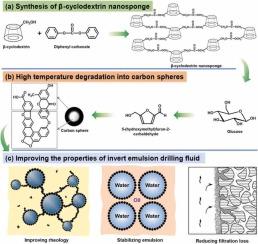Effect of β-cyclodextrin nanosponges on the rheology, filtration and emulsion stability of invert emulsion drilling fluids under elevated temperatures
IF 6.2
1区 农林科学
Q1 AGRICULTURAL ENGINEERING
引用次数: 0
Abstract
In this study, we synthesized β-cyclodextrin nanosponges (β-CDNSs) via crosslinking between β-cyclodextrin and diphenyl carbonate using a solvent method. Furthermore, we analyzed the variation of the invert emulsion drilling fluid properties in terms of the rheology, filtration, and emulsion stability subjected to thermal aging at various temperatures in the presence of β-CDNSs. Experimental results indicated that for temperatures below 160 °C, the drilling fluid properties exhibited a limited improvement following the inclusion of β-CDNSs. When the temperature was above 160 °C, hydrothermal carbonization occurred for an oil/water ratio below 9:1. The generated carbon spheres were adsorbed at the oil/water interface and served as emulsion stabilizers. These particles tended to form network structures and provided the desired rheological properties. They could also plug the micropores and reduce the permeability of the filter cake, thereby significantly reducing the filtration loss. The properties of conventional additives deteriorate gradually with an increase in the temperature; hydrothermal carbonization also changes the structure of β-CDNSs and generates carbon spheres above the critical temperature of 160 °C, which improves the performance of the invert emulsion drilling fluid. This study presents a novel method to adjust the properties of invert emulsion drilling fluid under high-temperature conditions.

高温下β-环糊精纳米海绵对反乳化钻井液流变性、过滤性和乳化稳定性的影响
本研究采用溶剂法将β-环糊精与碳酸二苯酯交联合成β-环糊精纳米海绵(β-CDNSs)。此外,我们分析了在不同温度下β- cdns存在下,反乳化液钻井液在流变学、滤过性和乳液稳定性方面的变化。实验结果表明,当温度低于160°C时,加入β-CDNSs后,钻井液性能得到有限改善。当温度高于160℃时,油水比低于9:1时发生热液碳化。生成的碳球被吸附在油水界面,作为乳状液的稳定剂。这些颗粒倾向于形成网状结构,并提供所需的流变性能。它们还可以堵塞微孔,降低滤饼的渗透性,从而显著降低过滤损失。随着温度的升高,常规添加剂的性能逐渐变差;水热碳化还改变了β-CDNSs的结构,在临界温度160℃以上生成碳球,提高了反乳化钻井液的性能。提出了一种在高温条件下调节反乳化钻井液性能的新方法。
本文章由计算机程序翻译,如有差异,请以英文原文为准。
求助全文
约1分钟内获得全文
求助全文
来源期刊

Industrial Crops and Products
农林科学-农业工程
CiteScore
9.50
自引率
8.50%
发文量
1518
审稿时长
43 days
期刊介绍:
Industrial Crops and Products is an International Journal publishing academic and industrial research on industrial (defined as non-food/non-feed) crops and products. Papers concern both crop-oriented and bio-based materials from crops-oriented research, and should be of interest to an international audience, hypothesis driven, and where comparisons are made statistics performed.
 求助内容:
求助内容: 应助结果提醒方式:
应助结果提醒方式:


